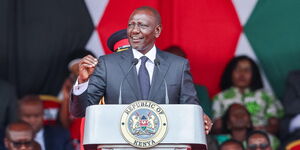On Monday, the Kenya Revenue Authority (KRA) surpassed the Ksh1 trillion mark in revenue collection for 2023 with three weeks to spare.
Despite Kenya excelling in revenue collection, the country continues to experience economic hardships as admitted by National Treasury Cabinet Secretary (SC) Njuguna Ndung’u on December 6.
The Treasury CS while appearing before the Parliamentary Finance Committee revealed that Kenya Kwanza was struggling to meet its financial obligations including remuneration of civil servants.
One of the main reasons the country is struggling is due to the contraction of the private sector.
For the last 11 months, Kenya has recorded above 50 points once (in August) in the Purchasing Managers Index (PMI).
A below 50-point score in the PMI indicates that there is negative growth in the private sector with businesses recording losses or closing altogether.
Some of the industries that have been affected by this contraction include; manufacturing, agriculture, mining, services, construction and retail sectors.
Negative growth in the private sector means that the country misses on millions collected through Value Added Tax (VAT), Pay As You Earn (PAYE), and Corporations among other taxes.
The country has also been struggling financially due to an increase in fuel prices.
According to the Transport Index, the increased fuel prices have had a negative impact on revenue collection.
With the price of petrol and diesel trading at Ksh217 and Ksh205 respectively, many motorists have resorted to using public means of transport affecting revenue collection negatively.
Lastly, the shedding off of Kenyan Shilling worth has threatened to cripple the country’s economy.
A weak Kenyan Shilling has caused upward pressure on prices of basic commodities which has subsequently raised the cost of living and reduced the purchasing power of many households.
Additionally, the weakening of the Shilling which has seen the local currency trade against the dollar at above Ksh150 for the first time in history has affected import demand.
Many importers have been wary of the high exchange rates which erode their capital thereby reducing the quantities imported.
The increased cost of importation due to weak Shilling is passed on to the consumer which has seen prices of commodities increase significantly.












